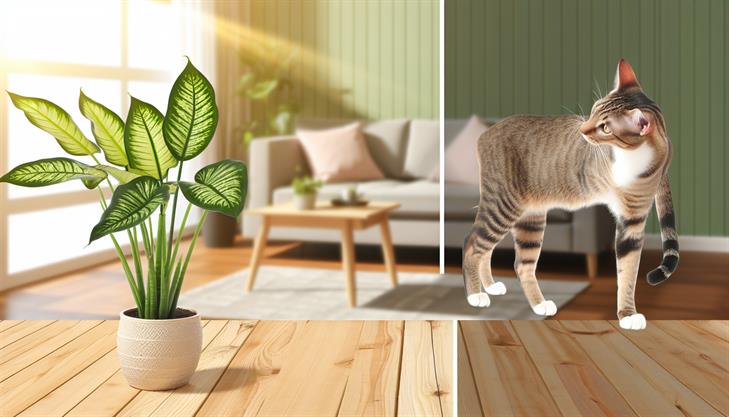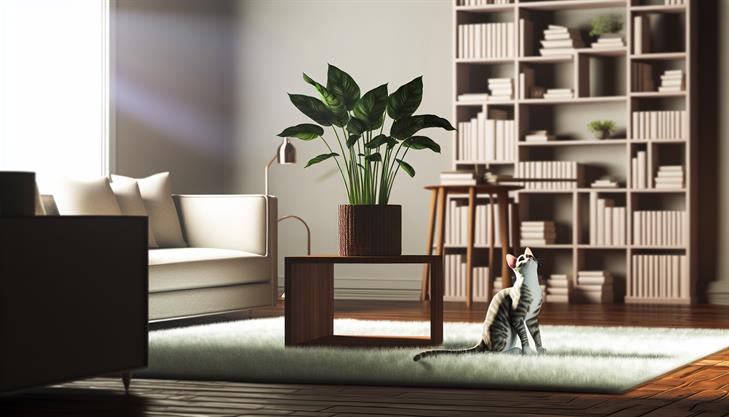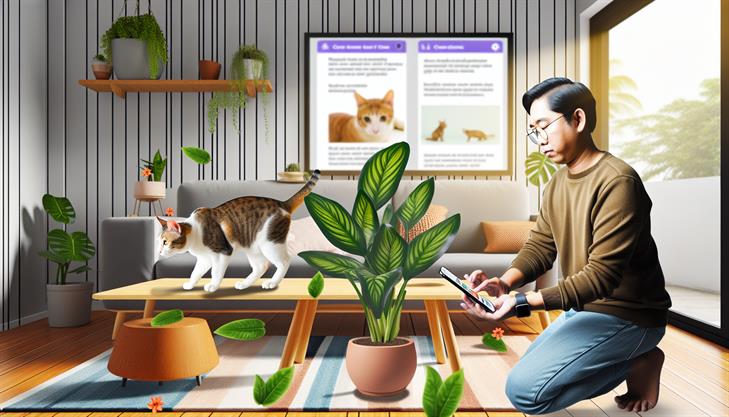Picture this: You’ve just brought home a new plant, the captivating Calathea, with its lush, striped leaves adding a touch of the exotic to your living space. But as you admire your new green companion, a concerning thought creeps in—what if your curious feline friend decides to take a nibble? As a pet owner, your furry friend’s safety is paramount, and understanding the potential risks of introducing new plants into your home is crucial. In this comprehensive guide, we’ll delve into the relationship between Calathea plants and cats, providing you with peace of mind and ensuring your home remains a safe haven for your beloved pet. Whether you’re a seasoned plant enthusiast or a beginner exploring the world of greenery, understanding plant toxicity in relation to pets is essential. Get ready to clear up any confusion and confidently create a pet-friendly botanical oasis around you.
Understanding Calathea: What It Is and Why You Should Care
Calathea, known for its strikingly beautiful foliage and wide variety of patterns, is a popular choice for houseplant enthusiasts. If you’re a plant lover with pets, though, the safety of your furry friends is likely a primary concern when choosing the right plants. A frequent query is whether Calathea is toxic to cats. The good news is that Calathea plants are non-toxic to cats, making them a pet-friendly option for your home or garden.
The Appeal of Calathea
Before delving into the aspects of pet safety, it’s helpful to understand what makes Calathea appealing. These plants are appreciated for their vibrant leaves, which feature intricate designs and patterns in a range of colors from rich greens to deep purples. Originating from the tropical regions of the Americas, Calathea thrives in humid environments, which makes them ideally suited for bathroom decor where moisture levels are naturally higher.
Non-Toxic Nature of Calathea
According to the ASPCA (American Society for the Prevention of Cruelty to Animals), Calathea is non-toxic to cats, dogs, and other pets. This feature makes it an excellent addition to households concerned about plant toxicity. Pet owners can breathe a sigh of relief knowing that their inquisitive cats, which may often chew on leaves, won’t be harmed by these plants.
Integrating Calathea Into Your Home Safely
-
Placement: Although Calathea is safe, it’s always a good idea to place plants out of reach if your cat tends to be overly curious or particularly destructive. This not only prevents any accidental plant damage but also keeps the area tidy.
-
Environment: Calathea prospers in indirect light and high humidity. Place it in a spot where it can enjoy warmth and a bit of misting if necessary. A bathroom window with filtered light could be an ideal place.
-
Watering Needs: When caring for Calathea, ensure you water them with distilled water as these plants are sensitive to minerals and chemicals. Keep the soil consistently moist but not waterlogged. Too much water can result in root rot, affecting plant health.
Common Issues with Calathea
While Calathea is safe for pets, it comes with its own set of care challenges. One common problem is leaf curling, which is usually a result of inadequate humidity or insufficient water. Ensuring a consistent watering schedule and occasionally misting the leaves can help mitigate this problem.
Another issue is browning leaves, often due to exposure to cold drafts or direct sunlight. It’s crucial to find a balanced environment that mimics their natural tropical habitat.
Final Advice
While Calathea itself is not toxic to cats, if your pet has consumed any other houseplant and is displaying symptoms such as vomiting, drooling, or lethargy, you should seek veterinary advice immediately. It’s also wise to regularly prune your Calathea to promote healthy growth and minimize your cat’s temptation to chew on newly sprouted leaves.
In conclusion, Calathea offers both stunning aesthetic appeal and peace of mind for pet owners worried about plant toxicity. Proper care and placement ensure that both your plant and pets can coexist harmoniously, creating a beautiful and safe home environment.
Is Calathea Safe for Cats? Exploring the Science
When it comes to adding plants to your home, the safety of your pets is a top priority. For cat owners, this means understanding whether the plants you’re considering are harmful to your feline friends. One such plant often seen in households is the beautiful Calathea, known for its vibrant foliage. The question many cat owners ask is, "Is Calathea toxic to cats?"
Understanding Calathea’s Nature
Calathea plants, native to tropical regions, are renowned for their stunning, patterned leaves. The good news for pet owners is that Calatheas are generally non-toxic to cats. According to the American Society for the Prevention of Cruelty to Animals (ASPCA) and other reputable sources, Calatheas are safe and pose no harm to cats or dogs when ingested.
The Science Behind Non-Toxicity
The reason Calatheas are non-toxic lies in their chemical makeup. Unlike some plants that produce harmful compounds or saponins, Calatheas do not contain any substances known to be harmful to cats. This allows pet owners to enjoy the aesthetic benefits of these plants without worrying about their pets’ health.
Common Concerns and Considerations
While Calatheas are safe, it’s important to recognize a few considerations:
-
Potential for Digestive Upset: Although Calatheas are not toxic, any plant material ingested in large amounts can cause mild digestive disturbances in cats, including vomiting or diarrhea. This is usually not serious but is something to watch for.
-
Allergic Reactions: Though rare, some cats could exhibit allergic reactions to new plants in the home. Monitor your cat for any signs of irritation or allergic response, such as excessive scratching or sneezing, when introducing a Calathea.
Tips for Introducing Calathea Into Your Home
Here are step-by-step tips on safely adding Calathea to your household:
-
Place Strategically: Initially, position the Calathea in a spot that your cat has limited access to, especially if they are known to chew on plants. This can be on a high shelf or within a terrarium.
-
Monitor Interaction: Observe how your cat interacts with the new plant. If your cat shows too much interest or begins nibbling, you might want to reposition the plant or use cat deterrents like citrus peels around the pots.
-
Provide Alternatives: To distract your cat from the Calathea, offer pet-safe grass or other chew-friendly plants like catnip elsewhere in the home.
-
Regular Plant Care: Keep your Calathea healthy with adequate care—lights, water, and humidity—which not only ensures your plant thrives but removes any temptation for your cat due to soil bugs or wilted leaves, which might otherwise attract them.
Conclusion
Incorporating a Calathea into your home is a safe choice for cat owners seeking a vibrant, lush touch without compromising their pet’s safety. While Calatheas are non-toxic, observing your cat’s relationship with the plant ensures a harmonious living environment. By understanding these nuances, you can confidently enjoy the beauty of Calathea alongside your feline companions.
Tips for Pet-Friendly Plant Care
If you’re a pet owner and a plant enthusiast, maintaining a home that is safe for both your feline friends and your green companions can be a delicate balance. One common concern involves the question: is calathea toxic to cats? Fortunately for cat lovers, calathea plants are non-toxic to both cats and dogs, making them a great choice for those looking to add a touch of greenery without risking their pet’s health.
Calathea, known for their vibrant and ornate foliage, are not only harmless to cats, but they also add beauty to any indoor space. Here are some tips and steps to ensure both your calathea plants and your cats thrive harmoniously under one roof:
Ensuring a Pet-Friendly Environment with Calathea:
-
Placement and Positioning:
- Position your calathea out of reach of curious paws, especially if your cat has a habit of knocking things over. High shelves or plant stands can be useful.
- Ensure that wherever you place the plant, it gets indirect sunlight, as direct sunlight can damage the leaves.
-
Understanding Cat Behavior:
- Cats often chew on plants out of curiosity or boredom. Keep your cat entertained with toys or engage them in play to deter them from the plants.
- If needed, use deterrents like citrus peels around the plant base, as cats typically dislike citrus scents.
-
Proper Care for Calathea:
- Watering: Calathea plants thrive in moist soil but are sensitive to overwatering. Water them when the top inch of soil feels dry to the touch.
- Humidity: These plants love humidity, so placing a humidifier nearby or grouping the plant with others can help maintain ideal moisture levels.
-
Monitoring and Maintenance:
- Regularly inspect your calathea for any signs of stress or pest infestations, which can be exacerbated in a home with pets that might occasionally disturb the plants.
- Clean the leaves gently with a damp cloth to remove dust and allow the plant to photosynthesize effectively.
-
Creating Safe Alternatives for Cats:
- Provide cat grass or catnip as an alternative to calathea leaves. This can satisfy their need to chew while keeping them safe.
- Consider setting up a dedicated cat corner with feline-friendly plants to draw their attention away from other houseplants.
By following these steps, you can cultivate a home that is both a safe haven for your cats and a thriving environment for your calathea plants. Not only does having non-toxic plants like calathea decrease the risk of harm to your pets, but it also allows you to enjoy a lush, indoor garden without constant worry. Always remember, the key to a harmonious coexistence is observation and adaptation—watch how your pets interact with your plants, and adjust your strategies accordingly.
What to Do if Your Cat Eats a Calathea
If your cat has ingested a Calathea plant, you might be concerned about potential toxicity. Fortunately, Calathea plants are not toxic to cats, making them a popular choice for pet owners looking to enhance their indoor spaces with greenery. However, there are still some important steps to take if your cat decides to munch on a leaf.
Immediate Actions:
-
Assess Your Cat’s Behavior:
- Check if your cat is showing any signs of distress such as vomiting, diarrhea, drooling, or lethargy. Even though Calathea isn’t toxic, ingesting any plant material can occasionally cause mild gastrointestinal upset.
-
Remove Plant Material:
- Gently remove any remaining plant material from your cat’s mouth to prevent further ingestion.
-
Monitor Hydration:
- Ensure your cat has access to fresh water. Drinking water can help flush out any minor irritants.
Observe Your Cat:
- Keep a close eye on your cat for at least 24 hours after eating the plant. Although unlikely, if you notice persistent symptoms like vomiting or diarrhea, consider consulting your veterinarian. Recurrent symptoms may be due to an underlying condition unrelated to the Calathea.
Preventing Future Incidents:
-
Reposition Your Plants:
- Move your Calathea to a less accessible area. Consider placing it on a higher shelf or in a room that your cat cannot enter.
-
Introduce Cat-Safe Alternatives:
- Provide your cat with safe plants to chew, such as wheatgrass or catnip, to deter them from less favorable options.
-
Training:
- Use deterrents like citrus peels or specially designed sprays around your plants to discourage your cat from approaching them.
Common Misconceptions:
It’s important to note that not all houseplants are cat-safe, but in the case of Calathea, it is non-toxic. Some similar-looking plants might be harmful, so it’s a good practice to research each new plant before bringing it into a pet-friendly home.
Additional Advice:
-
Regular Vet Visits:
Keep up with your cat’s routine health check-ups to ensure they are overall healthy and to discuss any concerns about their interactions with different plants. -
Pet-Safe Household:
When selecting houseplants, choose varieties like spider plants, Boston ferns, or bamboo palms that are also recognized as non-toxic to cats.
In conclusion, while Calathea is not toxic to cats, always be mindful of your pet’s behavior around houseplants. Taking preventative measures ensures a safe environment for your feline friends while enjoying the aesthetic benefits of a lush, green home.
Troubleshooting Common Plant Safety Concerns for Cat Owners
When considering the incorporation of houseplants in a cat-friendly environment, understanding which plants could potentially harm your feline friends is crucial. One common question many cat owners have is, "Is calathea toxic to cats?" Fortunately for plant enthusiasts, calathea is non-toxic to cats, making it a safe addition to any home with curious pets.
Understanding Calathea:
Calatheas are popular for their vibrant foliage and intricate leaf patterns. Native to tropical regions, these plants thrive indoors with proper care, offering both aesthetic appeal and a pet-friendly atmosphere.
Common Issues with Pets and Plants:
Even though calathea is non-toxic, cats may still be tempted to chew on its leaves due to its texture and movement. Here’s how to manage such situations effectively:
-
Monitor Your Cat’s Behavior: Keep a close watch on how your cat interacts with the plant. Some cats may ignore it entirely, while others might show more interest.
-
Provide Alternatives: Ensure that your cats have plenty of engaging toys or safe plants they can nibble on, such as cat grass or catnip, to divert their attention away from your calathea.
-
Safe Placement: Position your calathea in a spot that’s less accessible to your cat. High shelves, plant stands, or hanging planters can be useful to keep the plant out of reach.
-
Training and Deterrents: Train your cat to avoid the plant by using safe deterrents like citrus peels around the plant’s base or placing double-sided tape nearby, as cats tend to dislike these textures and smells.
Plant Care Tips for Cat Owners:
To ensure that your calathea thrives while remaining safe for your cats, follow these care guidelines:
-
Light and Humidity: Place your calathea in an area with indirect sunlight and higher humidity. Bathrooms or kitchens are ideal, but remember to ensure easy access for maintenance.
-
Watering Regimen: Keep the soil consistently moist but not waterlogged. Overwatering can lead to root rot, which may indirectly affect air quality.
-
Regular Maintenance: Inspect your plants regularly for any signs of stress or pest infestations, which could alter their appeal to pets.
Additional Advice:
If your cat does manage to chew on a calathea leaf, there’s no need to panic considering their non-toxic nature. However, monitor your pet for any unusual behavior, like vomiting, as ingesting large quantities of plant material could still lead to mild gastrointestinal upset. Consult your veterinarian for peace of mind if any symptoms arise.
In conclusion, with its non-toxic nature, calathea is a cat-friendly plant option that allows you to enjoy the beauty of greenery without compromising your pet’s safety. By taking proactive steps, you can ensure that both your plants and your pets coexist harmoniously in their shared environment.
In conclusion, understanding whether calathea plants are toxic to cats is crucial for pet owners aiming to create a safe and vibrant home environment. As highlighted in our discussion, calatheas are non-toxic to cats, making them a favored option for those who adore both plants and pets. We explored how these alluring plants can coexist harmoniously with your feline friends, with little risk of harm.
However, while calatheas are safe, it’s always wise to remain vigilant about your cat’s interactions with all household plants, as the ASPCA reminds us that every animal’s response can vary. Employ simple strategies like placing plants in locations that are less accessible to curious cats and continually researching other plant options to ensure a pet-friendly home.
As a final tip, consider offering your cat-safe alternatives such as cat grass or catnip, which can satisfy their natural curiosity and minimize any potential nibbling on houseplants. By making informed choices and being proactive, you can enjoy the beauty of calatheas while ensuring your beloved cats are completely safe.


